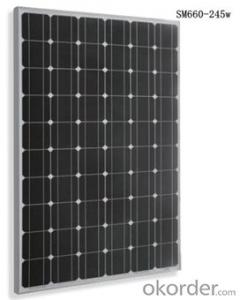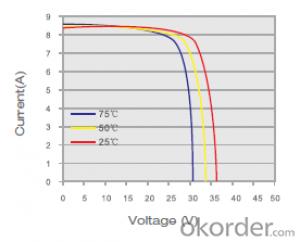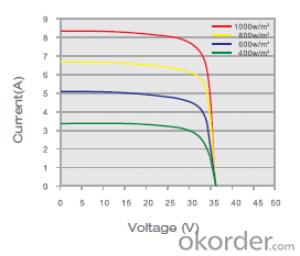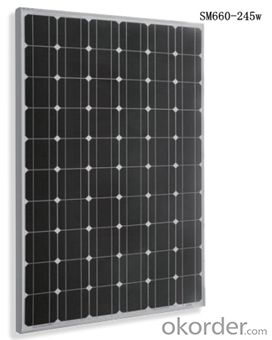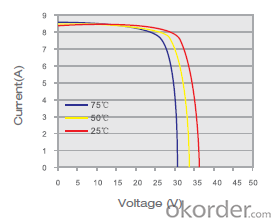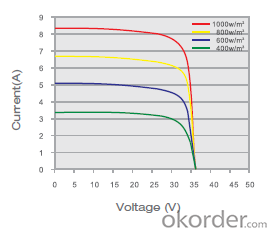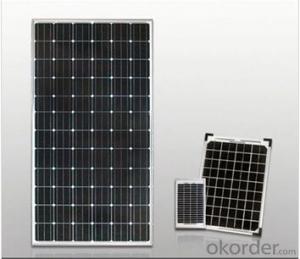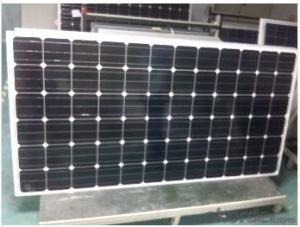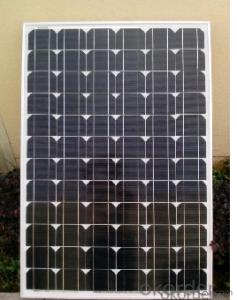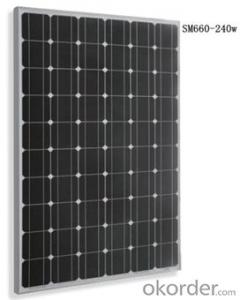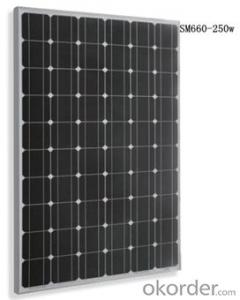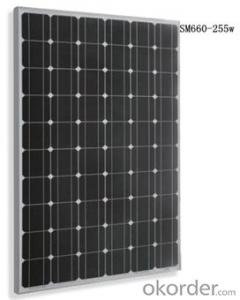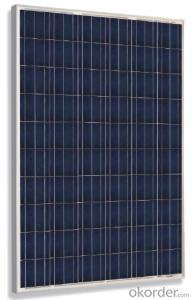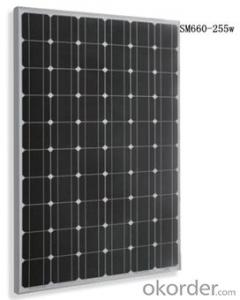Solar Panels Hawaii Monocrystalline Solar Module SM660-245W
- Loading Port:
- Shanghai
- Payment Terms:
- TT OR LC
- Min Order Qty:
- 25 set
- Supply Capability:
- 8000 set/month
OKorder Service Pledge
OKorder Financial Service
You Might Also Like
Product Description:
1.Structure of Monocrystalline Solar Module SM596 245W Series Description:
Monocrystalline Solar Module SM596 245W: High efficiency crystalline solar cell. Even if under the weak light, the solar module can produce maximum power output.
II Tempered glass (toughened glass): Anti-reflecting coating and high transmission rate glass increase the power output and mechanical strength of solar module.
III EVA and TPT: Using high quality EVA and TPT to prevent destroying and water.
IV AI frame: Without screw, rner connection. 6 holes on the frame can be installed easily.
V Junction box: Multi function junction box with water proof.
VI Long lifetime: ≥25 years; Less power decrease.
VII Good performance of preventing from atrocious weather such as wind and hails.
VIII Resisting moisture and etching effectively, not effected by geology.
IX The certificate issued by international authority: TUV, IEC, CE.ISO9001.MCS
2. Standard Test Conditions of Monocrystalline Silicon Solar Panel:
The opto-electrical specifications shown below are stabilized values being measured at Standard Test Conditions, Irradiance: 1000W/m2, Spectrum: AM1.5 at 25°C, The info below is subject to manufacturing tolerances. Where appropriate minutes of measurement are available and are used for the dimensioning of the installation.
Advantages of Polycrystalline Silicon Solar Panel
• 25 year transferrable power output warranty: 10 years / 90%, 25 years / 80%*
• 12 year material and workmanship warranty
• Timeliness of delivery
• Quality Products certified (TUV, IEC, CE.ISO9001.MCS)
3. Characteristics of Monocrystalline Silicon Solar Panel:
• Guaranteed tolerance +3%
• High manufacture standards
• Reliable power output
• High module efficiency
• Module efficiency up to 15.5%
• Cells efficiency up to 17.6%
• Strong compressive strength
• Certified to withstand high wind of 2400Pa
4. Solar Panel Images
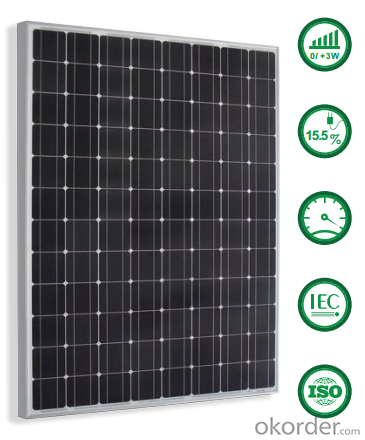
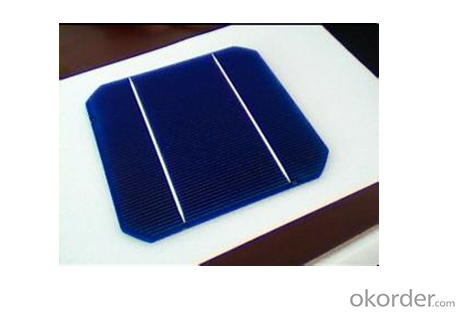


5. Monocrystalline Silicon Solar Panel Specification
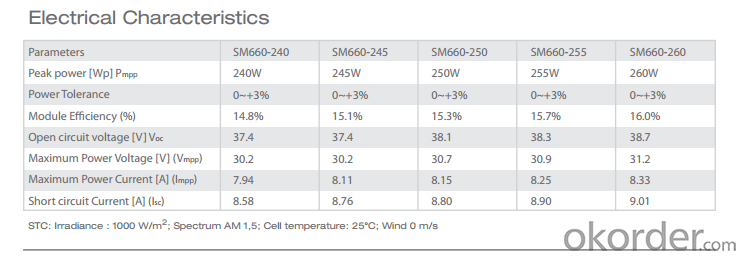
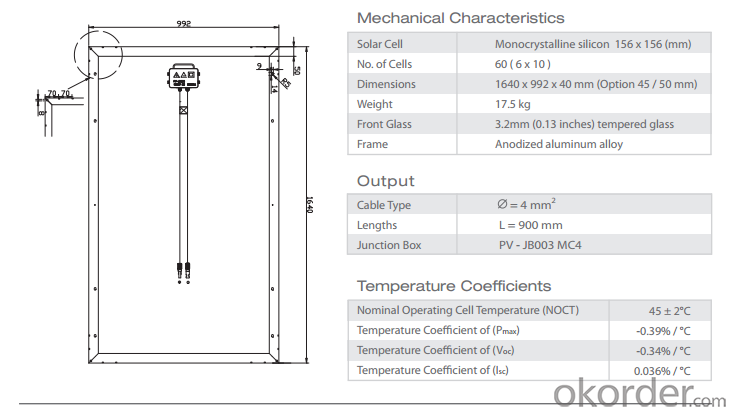


6.FAQ
We have organized several common questions for our clients,may help you sincerely:
①How about your company?
We are a private-owned high-tech company who specializes in developing, manufacturing and marketing of silicon ingots, solar wafer, solar cells, solar modules, PV systems and solar applications products.
At present, We has one research & development team, whose members are well-known experts in photovoltaic area. We also have advanced production and test equipment.
②How to guarantee the quality of the products?
Our products have been certified by CE, CEC,MCS, IEC61215, IEC61730 and ISO9001.
• 25 year transferrable power output warranty: 10 years / 90%, 25 years / 80%*
• 12 year material and workmanship warranty
• Timeliness of delivery
• Quality Products certified (TUV, IEC, CE.ISO9001.MCS)
③How long can we receive the product after purchase?
In the purchase of product within three working days, We will arrange the factory delivery as soon as possible. The pecific time of receiving is related to the state and position of customers.Commonly 7 to 10 working days can be served.
- Q: Where can I find updated info about solar panels for home?
- I am a solar consultant within the state of South Carolina. I can answer questions and provide you with links that may help in decision making. Let me know.
- Q: How do solar panels impact air pollution?
- Solar panels have a positive impact on air pollution as they produce clean energy without emitting harmful pollutants or greenhouse gases into the atmosphere. By replacing fossil fuel-based energy sources, solar panels help reduce air pollution and improve air quality, resulting in a healthier and more sustainable environment.
- Q: Can solar panels be used for powering a telecommunications tower?
- Yes, solar panels can be used to power a telecommunications tower. Solar panels convert sunlight into electricity, which can be used to power various equipment including telecommunication towers. This renewable energy source is increasingly being adopted for powering such infrastructure, as it provides a clean and sustainable solution, especially in remote or off-grid locations.
- Q: Can solar panels be installed in shaded areas?
- Solar panels can be installed in shaded areas, but their efficiency and energy production will be significantly reduced.
- Q: I need a new roof soon and I was wondering what the difference in cost would be from a standard shingle roof to a roof including solar panels. Does anyone know the cost difference?
- The solar panels are very expensive to provide much power. If u go that way do not skimp on the support as a high wind will blow them away. In Ecuador I put in a remote site for communications. It was working good when a Strong wind blew $0.000 worth of solar panels all over the jungle.
- Q: Hi everyone, I am a novice in solar energy system. I want to know if I am on the right track. Recently I bought a 30 W solar panel, 5 Amp controller, and a 22 Ah battery, how many watts and what kind of INVERTER do I need? I did an research some said 50 W and some said 300 W. And am I right on the 5 amp controller and 22 Ah battery to provide larger output of electric, or the higher the # the greater output for 30 W solar panel?Really appreciate for anyone who help!!!
- With a 30 watt panel, producing about 2 amps, your not going to have much power from that. A 22 AH battery will give you 2 AH of usage. A battery should never be drained below 50%. What this works out to be is simply Amp draw for 2 hours. Which equals to 2V light bulb that draws amp for 2 hours. Not much. Now to replace that usage with your 30 watt panel, provided the panel is clean and in max sunlight, it will take 6 hours. If you attach an inverter to your system for 5 Volt Usage then the DC voltage drawn from the battery is very high. Example: Say you use a 5 Volt component that requires 50 Watts per hour to operate. The inverter will draw 5 Amps out of the Battery every hour to operate that component. That gives you and /2 of use before the battery is down to 50%.. Maybe that will be enough to charge up a standard Laptop battery. I have 2 30 Watt panels that produce 5 Amps, 4 6V batteries that have 480 AH and a 25 Amp Controller with a booster that increase the amp output to 20 Amps per hour. I live full time in an RV and raise the panels to get max output when I am parked. This system provides me with all the 5V throught the 500 Watt inverter that I need. Good luck on you system.
- Q: Dear Friends, I am very much worried about Global warming, So to contribute something for reducing Global Warming I have decided to use Solar Panels. Can anybody tell me what is the price of these Solar Panels and why people are not using them when they are environment friendly. What are the Pros and Cons of these Solar Panels?
- In the US and western Europe, the average cost to install a solar system.....panels, wire, battery bank inverters and all of that is $5 ( five) US a watt. ( One panel, 2 x 3 feet putting out 75 Watts costs $700-800 US ) Mos American homes use about 000 kilo Watt hours of electricity a month.. oking, heating, cooling, refrigeration, water lights and all that. that is 2,000 kilowatts a year. A solar panel system would therefore cost $60,000 US to install. That is WAY beyond almost everyone's means, which is why the US and Europe is not covered in solar panels. There is also the amount of sunlight per day and the height of the sun in the sky. There is a formula to figure out how much usable sunlight a day you get; the further north the less......and that number averages out to about 5 hours a day year round. So back to the 000 kW a month.......30 + kWh a day.......in 5 hours a day you have to generate 6,000 watts .... divide by 75 watts a panel = 35 panels x 75.00 per = 25,000 $ US plus wiring, batteries and all that........
- Q: Where can I find the info (sites) that clearly gives the anatomy of a solar panel?Likewise, I want to know where can I find (sites) the solar panel that produces 3.75 v? Thank you very much!!!
- You've probably seen calculators that have solar cells -- calculators that never need batteries, and in some cases don't even have an off button. As long as you have enough light, they seem to work forever. You may have seen larger solar panels -- on emergency road signs or call boxes, on buoys, even in parking lots to power lights. Although these larger panels aren't as common as solar powered calculators, they're out there, and not that hard to spot if you know where to look. There are solar cell arrays on satellites, where they are used to power the electrical systems. You have probably also been hearing about the solar revolution for the last 20 years -- the idea that one day we will all use free electricity from the sun. This is a seductive promise: On a bright, sunny day, the sun shines approximately ,000 watts of energy per square meter of the planet's surface, and if we could collect all of that energy we could easily power our homes and offices for free.
- Q: Can solar panels be installed on research facilities or laboratories?
- Yes, solar panels can be installed on research facilities or laboratories. In fact, many research facilities and laboratories have started to adopt solar energy to reduce their carbon footprint and dependence on traditional energy sources. Solar panels can be installed on rooftops or open spaces adjacent to the facility, providing clean and sustainable energy to power various equipment and operations. Additionally, the installation of solar panels on research facilities can serve as a demonstration of renewable energy technologies and encourage further adoption within the scientific community.
- Q: how the energy of load connected to solar PV measure.?Want too the basic idea about it.The role of current flowing thrugh the load?Can u explain with example..can explain simply?Im not an electrical student so explain very basics
- Most PV solar panels are labelled with their peak power output - this is the maximum power (measured in Watts) which that panel can generate in full sunlight. Remember these simple formula- V=IR and P=VI The current flowing through load keep the flow of electrons and thus energy is produced.
Send your message to us
Solar Panels Hawaii Monocrystalline Solar Module SM660-245W
- Loading Port:
- Shanghai
- Payment Terms:
- TT OR LC
- Min Order Qty:
- 25 set
- Supply Capability:
- 8000 set/month
OKorder Service Pledge
OKorder Financial Service
Similar products
Hot products
Hot Searches
Related keywords
